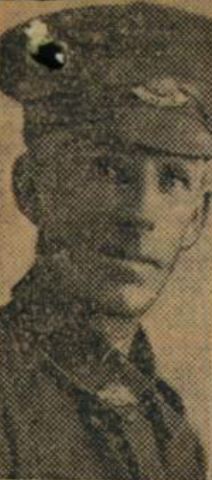Pte
Alexander Douglas Auld
Informations sur naissance
|
Année de naissance: 1877 |
|
Lieu de naissance: Surry Hills, Sydney, New South Wales, Australia |
Informations générales
|
Profession: Ouvrier du tabac |
Informations service militaire
|
Pays: Australia |
|
Force armée: Australian Imperial Force |
|
Rang: Private |
|
Numéro de service: 4653 |
|
Incorporation date: 11/11/1915 |
|
Incorporation nom de lieu: Casula, New South Wales, Australia |
|
Unités: — Australian Infantry, 20th Bn. (New South Wales) (Dernière unité connue) |
Informations sur décès
|
Date de décès: 09/10/1917 |
|
Lieu de décès: Keerselaarhoek, Belgique |
|
Cause du décès: Killed in action (K.I.A.) |
|
Âge: 40 |
Cimetière
|
Buttes New British Cemetery, Polygon Wood Parcelle: V Rangée: A Tombe: 17 |
Distinctions et médailles 2
|
British War Medal Médaille |
|
Victory Medal Médaille |
Points d'intérêt 3
| #1 | Lieu de naissance | ||
| #2 | Lieu d'enrôlement | ||
| #3 | Lieu du décès (approximatif) |
Mon histoire
Private Alexander Douglas Auld served in the Australian Infantry 20th Battalion, part of the 5th Brigade, of the 2nd Australian Division.
On the 9th of October 1917 the 20th Battalion Australian Infantry took part in the Battle of Poelcapelle, a stage in the Third Battle of Ypres. The 2nd Australian Division was to cover the right flank of the 66th British Division, and it attacked with the 5th and 6th Australian Brigades, respectively on the left and right flank.
The 5th Australian Brigade attacked with the 20th Battalion, the 17th Battalion was in support. At 5.30 a.m. the barrage came down short and some shells fell behind the attacking troops. The men came under enfilade machine gun fire from a German position across the railway in the 66th Divisional area. Nevertheless they men were able to capture a German strongpoint at Defy Crossing. By 8.25 a.m. the Battalion took their first objective, the Red Line, which was occupied with only slight casualties.
The 17th Battalion moved through the 20th and advanced on the Blue Line, supported by parties of the 20th Battalion. The intermixed troops cleared Decoy Wood and Rhine. On the left the railway cutting was cleared with grenades and bayonets. The intermixed troops reached their final objective, but with so few men remaining, they were soon forced to pull back to the first objective, which they consolidated.
Private Alexander Douglas Auld was killed in action on the 9th of October 1917. According to a witness report in his Red Cross Wounded and Missing File, Private Alexander Douglas Auld’s body was lying in the front line at Passchendaele in October 1917. The 20th Battalion advanced that same day. Even so Private Alexander Douglas Auld was initially buried at Keerselaarhoek, near Defy Crossing. This spot may suggest that Private Alexander Douglas Auld was one of the men of the 20th Battalion who swerved left and ended up in the 66th Divisional area North of the Ypers-Roulers Railway. He was later reburied at Buttes New British Cemetery, in Polygonwood.
On the 9th of October 1917 the 20th Battalion Australian Infantry took part in the Battle of Poelcapelle, a stage in the Third Battle of Ypres. The 2nd Australian Division was to cover the right flank of the 66th British Division, and it attacked with the 5th and 6th Australian Brigades, respectively on the left and right flank.
The 5th Australian Brigade attacked with the 20th Battalion, the 17th Battalion was in support. At 5.30 a.m. the barrage came down short and some shells fell behind the attacking troops. The men came under enfilade machine gun fire from a German position across the railway in the 66th Divisional area. Nevertheless they men were able to capture a German strongpoint at Defy Crossing. By 8.25 a.m. the Battalion took their first objective, the Red Line, which was occupied with only slight casualties.
The 17th Battalion moved through the 20th and advanced on the Blue Line, supported by parties of the 20th Battalion. The intermixed troops cleared Decoy Wood and Rhine. On the left the railway cutting was cleared with grenades and bayonets. The intermixed troops reached their final objective, but with so few men remaining, they were soon forced to pull back to the first objective, which they consolidated.
Private Alexander Douglas Auld was killed in action on the 9th of October 1917. According to a witness report in his Red Cross Wounded and Missing File, Private Alexander Douglas Auld’s body was lying in the front line at Passchendaele in October 1917. The 20th Battalion advanced that same day. Even so Private Alexander Douglas Auld was initially buried at Keerselaarhoek, near Defy Crossing. This spot may suggest that Private Alexander Douglas Auld was one of the men of the 20th Battalion who swerved left and ended up in the 66th Divisional area North of the Ypers-Roulers Railway. He was later reburied at Buttes New British Cemetery, in Polygonwood.
Sources 3
|
20th Australian Infantry Battalion, (Australian War Memorial, Campbell (AWM), AWM4 23/37/27). https://www.awm.gov.au/collection/C1338583 Sources utilisées |
|
First Australian Imperial Force Personnel Dossiers, 1914-1920, (National Archives of Australia, Canberra (NAA), B2455, AULD A D). https://recordsearch.naa.gov.au/SearchNRetrieve/Interface/SearchScreens/NameSearch.asp Sources utilisées |
|
McCarthy C., The Third Ypres Passchendaele. The Day-by-Day Account, (London, Arms & Armour Press, 1995), pg. 104-106. Sources utilisées |
Complément d’informations 4
|
Commonwealth War Graves Commission Database https://www.cwgc.org/find-records/find-war-dead/casualty-details/480100 |
|
Namenlijst (In Flanders Fields Museum) https://namenlijst.org/publicsearch/#/person/_id=3f4b79d4-f289-4921-9dcd-64da1e93709c |
|
Lives of the First World War (Imperial War Museum) https://livesofthefirstworldwar.iwm.org.uk/lifestory/7346258 |
|
The AIF Project (UNSW Canberra) https://aif.adfa.edu.au/showPerson?pid=9296 |
